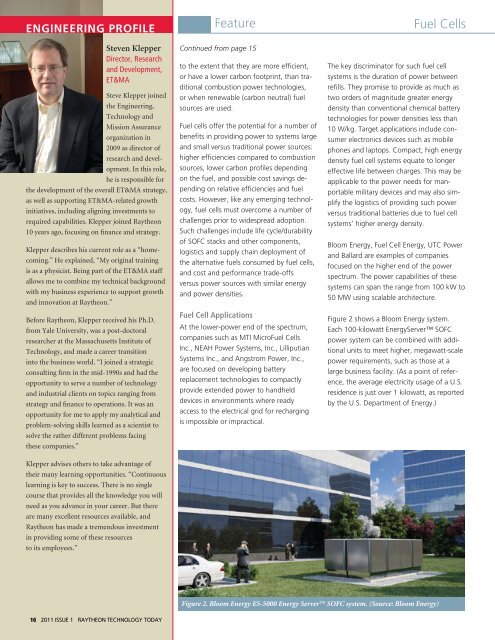Raytheon Technology Today 2011 Issue 1
Raytheon Technology Today 2011 Issue 1
Raytheon Technology Today 2011 Issue 1
You also want an ePaper? Increase the reach of your titles
YUMPU automatically turns print PDFs into web optimized ePapers that Google loves.
ENGINEERING PROFILE<br />
Steven Klepper<br />
Director, Research<br />
and Development,<br />
ET&MA<br />
Steve Klepper joined<br />
the Engineering,<br />
<strong>Technology</strong> and<br />
Mission Assurance<br />
organization in<br />
2009 as director of<br />
research and development.<br />
In this role,<br />
he is responsible for<br />
the development of the overall ET&MA strategy,<br />
as well as supporting ET&MA-related growth<br />
initiatives, including aligning investments to<br />
required capabilities. Klepper joined <strong>Raytheon</strong><br />
10 years ago, focusing on finance and strategy.<br />
Klepper describes his current role as a “homecoming.”<br />
He explained, “My original training<br />
is as a physicist. Being part of the ET&MA staff<br />
allows me to combine my technical background<br />
with my business experience to support growth<br />
and innovation at <strong>Raytheon</strong>.”<br />
Before <strong>Raytheon</strong>, Klepper received his Ph.D.<br />
from Yale University, was a post-doctoral<br />
researcher at the Massachusetts Institute of<br />
<strong>Technology</strong>, and made a career transition<br />
into the business world. “I joined a strategic<br />
consulting firm in the mid-1990s and had the<br />
opportunity to serve a number of technology<br />
and industrial clients on topics ranging from<br />
strategy and finance to operations. It was an<br />
opportunity for me to apply my analytical and<br />
problem-solving skills learned as a scientist to<br />
solve the rather different problems facing<br />
these companies.”<br />
Klepper advises others to take advantage of<br />
their many learning opportunities. “Continuous<br />
learning is key to success. There is no single<br />
course that provides all the knowledge you will<br />
need as you advance in your career. But there<br />
are many excellent resources available, and<br />
<strong>Raytheon</strong> has made a tremendous investment<br />
in providing some of these resources<br />
to its employees.”<br />
16 <strong>2011</strong> ISSUE 1 RAYTHEON TECHNOLOGY TODAY<br />
Feature<br />
Continued from page 15<br />
to the extent that they are more efficient,<br />
or have a lower carbon footprint, than traditional<br />
combustion power technologies,<br />
or when renewable (carbon neutral) fuel<br />
sources are used.<br />
Fuel cells offer the potential for a number of<br />
benefits in providing power to systems large<br />
and small versus traditional power sources:<br />
higher efficiencies compared to combustion<br />
sources, lower carbon profiles depending<br />
on the fuel, and possible cost savings depending<br />
on relative efficiencies and fuel<br />
costs. However, like any emerging technology,<br />
fuel cells must overcome a number of<br />
challenges prior to widespread adoption.<br />
Such challenges include life cycle/durability<br />
of SOFC stacks and other components,<br />
logistics and supply chain deployment of<br />
the alternative fuels consumed by fuel cells,<br />
and cost and performance trade-offs<br />
versus power sources with similar energy<br />
and power densities.<br />
Fuel Cell Applications<br />
At the lower-power end of the spectrum,<br />
companies such as MTI MicroFuel Cells<br />
Inc., NEAH Power Systems, Inc., Lilliputian<br />
Systems Inc., and Angstrom Power, Inc.,<br />
are focused on developing battery<br />
replacement technologies to compactly<br />
provide extended power to handheld<br />
devices in environments where ready<br />
access to the electrical grid for recharging<br />
is impossible or impractical.<br />
The key discriminator for such fuel cell<br />
systems is the duration of power between<br />
refills. They promise to provide as much as<br />
two orders of magnitude greater energy<br />
density than conventional chemical battery<br />
technologies for power densities less than<br />
10 W/kg. Target applications include consumer<br />
electronics devices such as mobile<br />
phones and laptops. Compact, high energy<br />
density fuel cell systems equate to longer<br />
effective life between charges. This may be<br />
applicable to the power needs for man-<br />
portable military devices and may also simplify<br />
the logistics of providing such power<br />
versus traditional batteries due to fuel cell<br />
systems’ higher energy density.<br />
Bloom Energy, Fuel Cell Energy, UTC Power<br />
and Ballard are examples of companies<br />
focused on the higher end of the power<br />
spectrum. The power capabilities of these<br />
systems can span the range from 100 kW to<br />
50 MW using scalable architecture.<br />
Figure 2 shows a Bloom Energy system.<br />
Each 100-kilowatt EnergyServer SOFC<br />
power system can be combined with additional<br />
units to meet higher, megawatt-scale<br />
power requirements, such as those at a<br />
large business facility. (As a point of reference,<br />
the average electricity usage of a U.S.<br />
residence is just over 1 kilowatt, as reported<br />
by the U.S. Department of Energy.)<br />
Figure 2. Bloom Energy ES-5000 Energy Server SOFC system. (Source: Bloom Energy)<br />
Fuel Cells

















